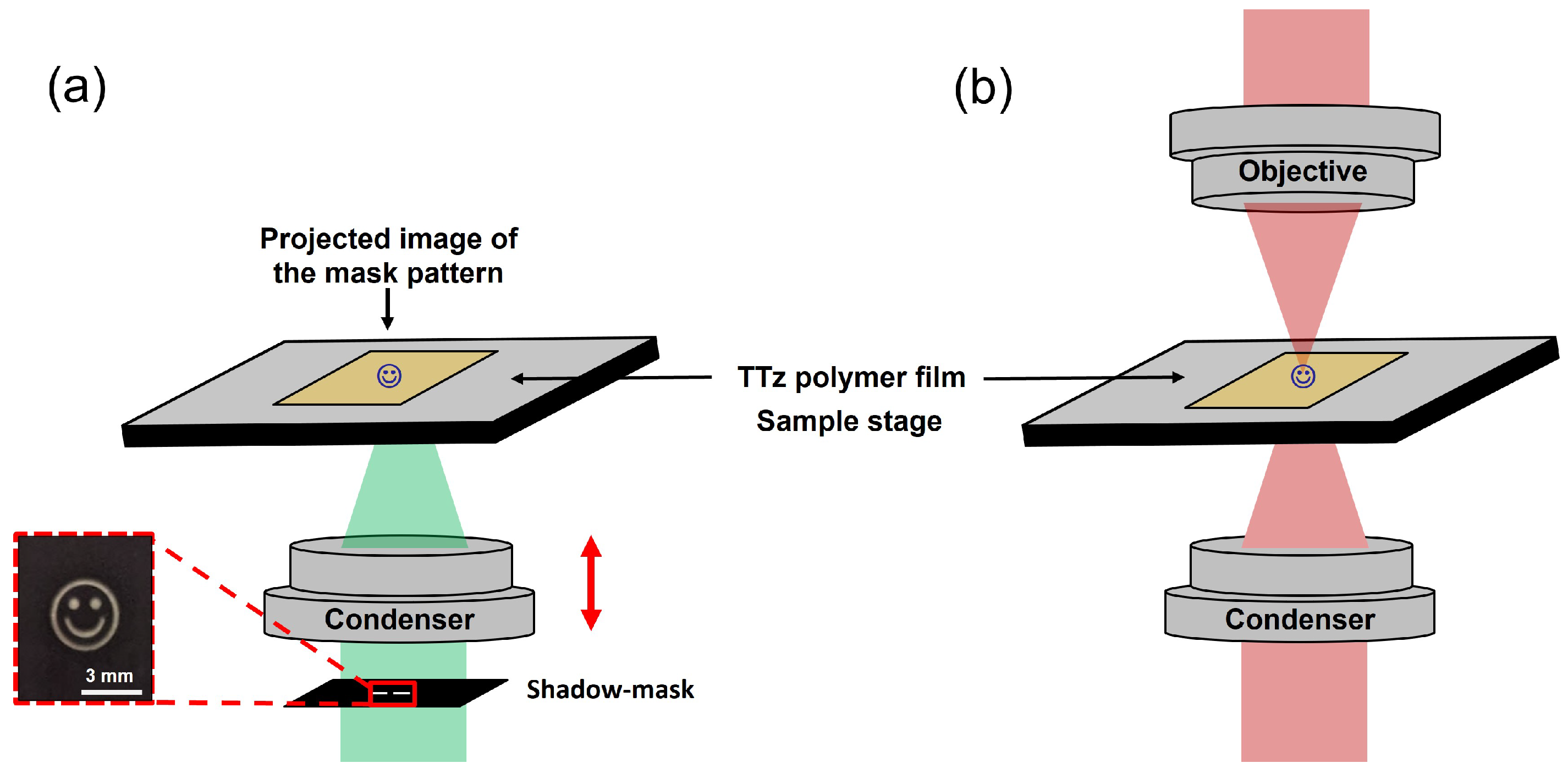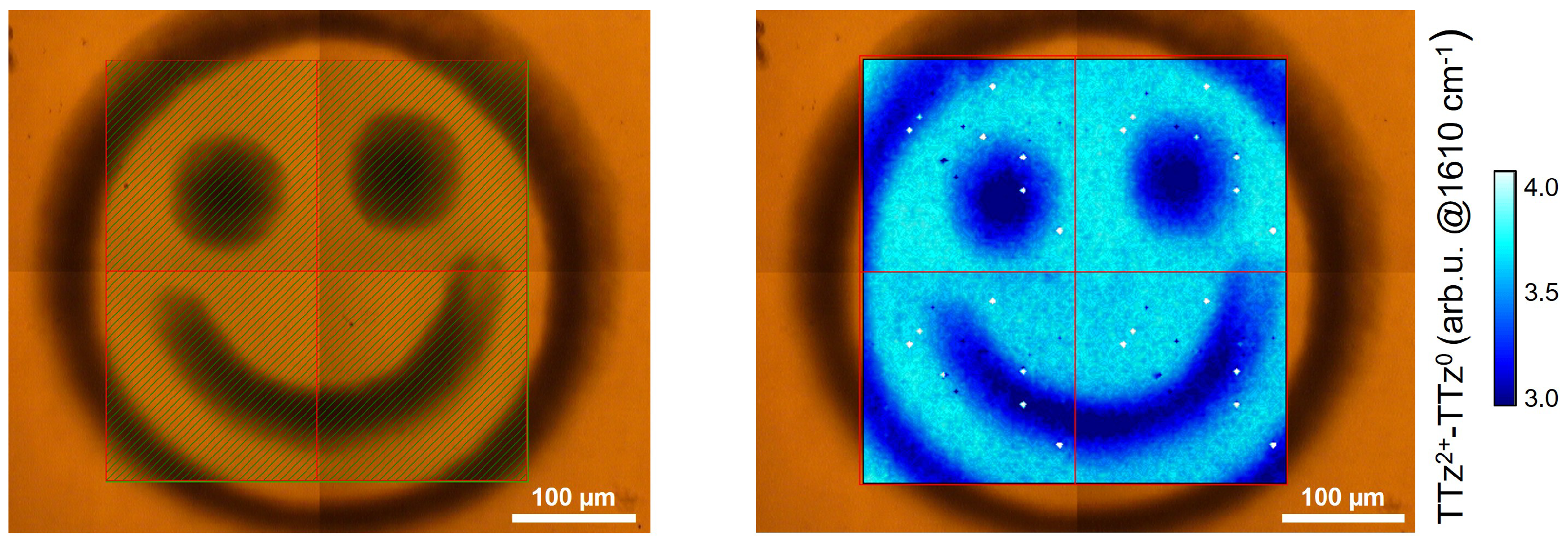Infrared Imaging of Photochromic Contrast in Thiazolothiazole-Embedded Polymer Films
Abstract
1. Introduction
2. Experiment
3. Results and Discussion
4. Conclusions
Author Contributions
Funding
Data Availability Statement
Acknowledgments
Conflicts of Interest
References
- Granqvist, C. Chromogenic materials for transmittance control of large-area windows. Crit. Rev. Solid State Mater. Sci. 1990, 16, 291–308. [Google Scholar] [CrossRef]
- Woodward, A.N.; Kolesar, J.M.; Hall, S.R.; Saleh, N.A.; Jones, D.S.; Walter, M.G. Thiazolothiazole fluorophores exhibiting strong fluorescence and viologen-like reversible electrochromism. J. Am. Chem. Soc. 2017, 139, 8467–8473. [Google Scholar] [CrossRef] [PubMed]
- Sayresmith, N.A.; Saminathan, A.; Sailer, J.K.; Patberg, S.M.; Sandor, K.; Krishnan, Y.; Walter, M.G. Photostable voltage-sensitive dyes based on simple, solvatofluorochromic, asymmetric thiazolothiazoles. J. Am. Chem. Soc. 2019, 141, 18780–18790. [Google Scholar] [CrossRef] [PubMed]
- Chen, Y.; Xiao, J.P.; Fan, M.G.; Yao, B. Organic photochromic materials for optical storage memory. In Proceedings of the Advances in Optical Data Storage Technology, Beijing, China, 8–10 November 2004; Volume 5643, pp. 73–78. [Google Scholar]
- Che, Y.; Wang, X.; Song, Q.; Zhu, Y.; Xiao, S. Tunable optical metasurfaces enabled by multiple modulation mechanisms. Nanophotonics 2020, 9, 4407–4431. [Google Scholar] [CrossRef]
- Österholm, A.M.; Shen, D.E.; Kerszulis, J.A.; Bulloch, R.H.; Kuepfert, M.; Dyer, A.L.; Reynolds, J.R. Four shades of brown: Tuning of electrochromic polymer blends toward high-contrast eyewear. ACS Appl. Mater. Inter. 2015, 7, 1413–1421. [Google Scholar] [CrossRef]
- Cho, H.; Kim, E. Highly fluorescent and photochromic diarylethene oligomer bridged by p-phenylenevinylene. Macromolecules 2002, 35, 8684–8687. [Google Scholar] [CrossRef]
- Ikeda, T.; Mamiya, J.i.; Yu, Y. Photomechanics of liquid-crystalline elastomers and other polymers. Angew. Chem. Int. Ed. 2007, 46, 506–528. [Google Scholar] [CrossRef]
- Bertarelli, C.; Bianco, A.; Castagna, R.; Pariani, G. Photochromism into optics: Opportunities to develop light-triggered optical elements. J. Photochem. Photobiol. C 2011, 12, 106–125. [Google Scholar] [CrossRef]
- Chen, S.; Liu, J.; Zhang, S.; Zhao, E.; Yu, C.Y.Y.; Hushiarian, R.; Hong, Y.; Tang, B.Z. Biochromic silole derivatives: A single dye for differentiation, quantitation and imaging of live/dead cells. Mater. Horizons 2018, 5, 969–978. [Google Scholar] [CrossRef]
- Pendry, J.B.; Schurig, D.; Smith, D.R. Controlling electromagnetic fields. Science 2006, 312, 1780–1782. [Google Scholar] [CrossRef]
- Ding, F. A Review of Multifunctional Optical Gap-Surface Plasmon Metasurfaces. Prog. Electromagn. Res. 2022, 174, 55–73. [Google Scholar] [CrossRef]
- Huang, C.; Zhang, C.; Yang, J.; Sun, B.; Zhao, B.; Luo, X. Reconfigurable metasurface for multifunctional control of electromagnetic waves. Adv. Opt. Mater. 2017, 5, 1700485. [Google Scholar] [CrossRef]
- Zang, X.; Dong, F.; Yue, F.; Zhang, C.; Xu, L.; Song, Z.; Chen, M.; Chen, P.Y.; Buller, G.S.; Zhu, Y.; et al. Polarization encoded color image embedded in a dielectric metasurface. Adv. Mater. 2018, 30, 1707499. [Google Scholar] [CrossRef] [PubMed]
- Wang, J.; Du, J. Plasmonic and dielectric metasurfaces: Design, fabrication and applications. Appl. Sci. 2016, 6, 239. [Google Scholar] [CrossRef]
- Tasolamprou, A.C.; Skoulas, E.; Perrakis, G.; Vlahou, M.; Viskadourakis, Z.; Economou, E.N.; Kafesaki, M.; Kenanakis, G.; Stratakis, E. Highly ordered laser imprinted plasmonic metasurfaces for polarization sensitive perfect absorption. Sci. Rep. 2022, 12, 19769. [Google Scholar] [CrossRef]
- Zhang, H.; Zhang, H. Thermally switchable and tunable metasurface with polarization independence based on VO2 phase transition. Phys.-Low-Dimens. Syst. Nanostruct. 2022, 139, 115121. [Google Scholar] [CrossRef]
- Tang, H.; Stan, L.; Czaplewski, D.A.; Yang, X.; Gao, J. Wavelength-tunable infrared chiral metasurfaces with phase-change materials. Opt. Express 2023, 31, 21118–21127. [Google Scholar] [CrossRef]
- Xiong, Y.; Wang, Y.; Feng, C.; Tian, Y.; Gao, L.; Wang, J.L.; Zhuo, Z.; Zhao, X. Electrically tunable phase-change metasurface for dynamic infrared thermal camouflage. Photonics Res. 2024, 12, 292–300. [Google Scholar]
- Kang, L.; Jenkins, R.P.; Werner, D.H. Recent progress in active optical metasurfaces. Adv. Opt. Mater. 2019, 7, 1801813. [Google Scholar] [CrossRef]
- Crano, J.; Guglielmetti, R.J. Organic Photochromic and Thermochromic Compounds Volume 1: Main Photochromic Families. Vol. 1; Kluwer Academic Publishers: New York, NY, USA, 1999; Volume 10, p. b115590. [Google Scholar]
- Konaka, H.; Wu, L.P.; Munakata, M.; Kuroda-Sowa, T.; Maekawa, M.; Suenaga, Y. Syntheses and structures of photochromic silver (I) coordination polymers with cis-1,2-dicyano-1,2-bis (2,4,5-trimethyl-3-thienyl) ethene. Inorg. Chem. 2003, 42, 1928–1934. [Google Scholar] [CrossRef]
- Bang, S.; Kim, J.; Yoon, G.; Tanaka, T.; Rho, J. Recent advances in tunable and reconfigurable metamaterials. Micromachines 2018, 9, 560. [Google Scholar] [CrossRef] [PubMed]
- Guo, Z.; Su, Y.; Zong, H.; Zhou, F.; Wang, M.; Zhou, G. A Universal Strategy for Reversible Photochromism of Viologen Derivatives in Solutions. Adv. Opt. Mater. 2024, 12, 2401791. [Google Scholar] [CrossRef]
- Adams, T.J.; Tumpa, N.F.; Acharya, M.; Nguyen, Q.H.; Shuchi, N.; Baliukonis, M.; Starnes, S.E.; Hofmann, T.; Walter, M.G. Achieving Smart Photochromics Using Water-Processable, High-Contrast, Oxygen-Sensing, and Photoactuating Thiazolothiazole-Embedded Polymer Films. ACS Appl. Opt. Mater. 2024, 2, 704–713. [Google Scholar] [CrossRef] [PubMed]
- Shuchi, N.Z.; Adams, T.J.; Tumpa, N.F.; Louisos, D.; Boreman, G.D.; Walter, M.G.; Hofmann, T. Infrared Dielectric Function of Photochromic Thiazolothiazole Embedded Polymer. arXiv 2025, arXiv:2503.22012. [Google Scholar]
- Adams, T.J.; Brotherton, A.R.; Molai, J.A.; Parmar, N.; Palmer, J.R.; Sandor, K.A.; Walter, M.G. Obtaining reversible, high contrast electrochromism, electrofluorochromism, and photochromism in an aqueous hydrogel device using chromogenic thiazolothiazoles. Adv. Funct. Mater. 2021, 31, 2103408. [Google Scholar] [CrossRef]



Disclaimer/Publisher’s Note: The statements, opinions and data contained in all publications are solely those of the individual author(s) and contributor(s) and not of MDPI and/or the editor(s). MDPI and/or the editor(s) disclaim responsibility for any injury to people or property resulting from any ideas, methods, instructions or products referred to in the content. |
© 2025 by the authors. Licensee MDPI, Basel, Switzerland. This article is an open access article distributed under the terms and conditions of the Creative Commons Attribution (CC BY) license (https://creativecommons.org/licenses/by/4.0/).
Share and Cite
Shuchi, N.Z.; Adams, T.J.; Tumpa, N.F.; Louisos, D.; Boreman, G.D.; Walter, M.G.; Hofmann, T. Infrared Imaging of Photochromic Contrast in Thiazolothiazole-Embedded Polymer Films. Optics 2025, 6, 20. https://doi.org/10.3390/opt6020020
Shuchi NZ, Adams TJ, Tumpa NF, Louisos D, Boreman GD, Walter MG, Hofmann T. Infrared Imaging of Photochromic Contrast in Thiazolothiazole-Embedded Polymer Films. Optics. 2025; 6(2):20. https://doi.org/10.3390/opt6020020
Chicago/Turabian StyleShuchi, Nuren Z., Tyler J. Adams, Naz F. Tumpa, Dustin Louisos, Glenn D. Boreman, Michael G. Walter, and Tino Hofmann. 2025. "Infrared Imaging of Photochromic Contrast in Thiazolothiazole-Embedded Polymer Films" Optics 6, no. 2: 20. https://doi.org/10.3390/opt6020020
APA StyleShuchi, N. Z., Adams, T. J., Tumpa, N. F., Louisos, D., Boreman, G. D., Walter, M. G., & Hofmann, T. (2025). Infrared Imaging of Photochromic Contrast in Thiazolothiazole-Embedded Polymer Films. Optics, 6(2), 20. https://doi.org/10.3390/opt6020020





